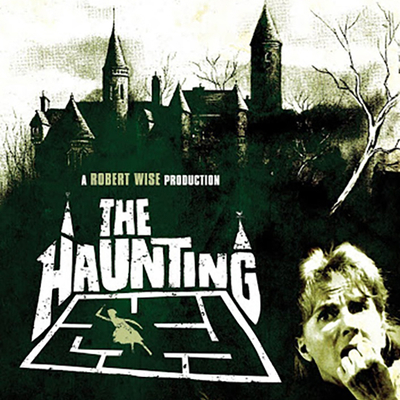It's worth noting that, while she was writing her novel The Haunting of Hill House, author Shirley Jackson was suffering from a barrage of physical and mental ailments that included anxiety and agoraphobia. You can't help but wonder that her vivid descriptions of a house that wasn't plagued by restless spirits as much as its own malevolence – "Hill House is vile, it is diseased," the main character says to herself upon her first glimpse of the place – weren't inspired by feeling trapped and wanting to blame the place of confinement and not yourself.
Here's hoping that, if there's any truly vital literary culture left, the pandemic lockdowns we've only just started to forget about should have inspired a renaissance of haunted house stories.
But what, you ask, is the difference between a ghost story and a haunted house story? Most of the time there's very little at all, with the notable exception of Jackson's novel and the movie it inspired, which came out four years after The Haunting of Hill House was published. A haunting implies a ghost, but Jackson's story only notionally hints that the eponymous home's builder and previous residents have any role at all in whatever has made Hill House such an awful, inhospitable place.
Robert Wise made The Haunting in 1963, between his melancholic romantic drama Two for the Seesaw (1962) and The Sound of Music (1965) – the film that, along with West Side Story (1961), sealed his fame (unfairly) as a great director of movie musicals. Wise has said that The Haunting was his favorite picture to make, and it's easy to see why, as it's full of the sinister mood of his early film noirs (Born to Kill, The Set-Up, The House on Telegraph Hill) and his taste for stories with psychological (I Want to Live!, Blood on the Moon, Three Secrets) or even fantastical themes (The Curse of the Cat People, The Day the Earth Stood Still).
Which is to say that if you only know Robert Wise from his two big musical hits or – God forbid – Star Trek: The Motion Picture, you're in for a surprise.
The Haunting begins with a misleading prologue that suggests that this will be a standard issue horror movie – a flashback sequence that lays out the backstory of Hill House and its eccentric New England blue blood builder, whose creation began taking lives the moment it was finished. This is, the narration tells us, "a house that was born bad."
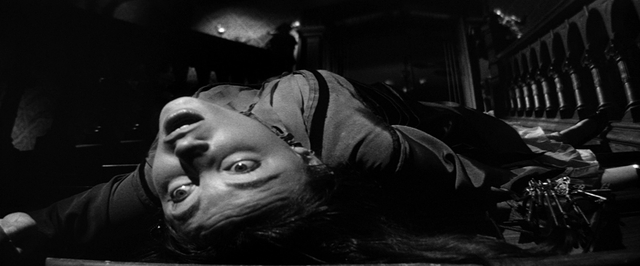
We meet Dr. John Markway (Richard Johnson), an academic who is devoting his sabbatical year to the study of the supernatural and Hill House in particular. He has to persuade the current owner of the empty mansion to lease it to him, and her only condition is that her ne'er-do-well nephew Luke (Russ Tamblyn) be included in the group of "researchers" Markway has invited to stay in the house with him.
Markway (Jackson called him Dr. Montague in her book) is a man of science with frayed loyalties to his discipline, intent on exploring the realm of what he calls the "preternatural" – that gray area between the rational and supernatural that he believes is where innovation and discovery reside.
In my first Halloween horror film review for this column, I talked about how horror films thrive on the tension between the skeptic and the believer, embodied in Dana Andrews' Holden and Niall MacGinnis' Karswell in Jacques Tourneur's Night of the Demon, who could also be described respectively as the critic and the fan. In Jackson's story, Markway/Montague is someone who desperately wants to believe. As she writes when introducing him:
"He had been looking for an honestly haunted house all his life. When he heard of Hill House he had been at first doubtful, then hopeful, then indefatigable; he was not about to let go of Hill House once he had found it."
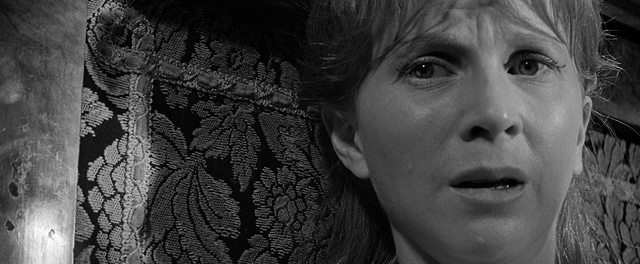
Eleanor is introduced next, a nervous spinster who has spent much of her life caring for an invalid mother who has just died. She's sleeping on the living room couch of a sister who is denying her what little autonomy she had when her mother was alive, and begging for the chance to borrow the car she half-owns to drive to Hill House and take up Markway's invitation to be one of his researchers.
Julie Harris plays Eleanor, and though Susan Hayward was in the running for the role (she had played the murderess on death row in I Want to Live!) Wise decided on Harris after seeing her onstage. Harris was a better choice, an actress with a talent for fragile characters like Frankie in The Member of the Wedding (1952) and Alison in Reflections in a Golden Eye (1967). Jackson is at pains that we understand Eleanor's precarious emotional state:
"She could not remember ever being truly happy in her adult life; her years with her mother had been built up devotedly around small guilts and small reproaches, constant weariness, and unending despair."
We see Eleanor make her escape, bribing the garage attendant to get to her car, before a long driving scene full of interior monologue establishes how desperate she is to find a home and a new life, even if it's in a haunted house. "Eleanor," Jackson wrote, "would have gone anywhere." If this sequence is familiar, it's because it echoes the one in Hitchcock's Psycho, released just three years earlier, where Janet Leigh's Marion is on the run after stealing money from her employer. Like Marion, Eleanor is on her way to a terrible place.
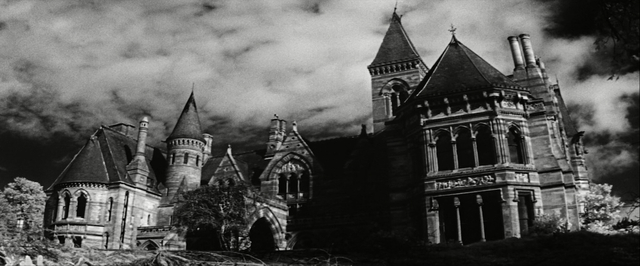
The house, once she's able to get there, is immediately ominous, and Wise chose Ettington Park in Warwickshire for the exterior of Hill House, a High Victorian Neo-Gothic country house built on foundations that go back to the Domesday Book (and currently a luxury hotel, with a spa & wellness centre, available for weddings.) Jackson is intent that we know the place is not to be underestimated:
"It was a house without kindness, never meant to be lived in, not a fit place for people or for love or for hope. Exorcism cannot alter the countenance of a house; Hill House would stay as it was until it was destroyed."
After running the gauntlet of the Dudleys, the hostile couple who work as the housekeepers of Hill House, Eleanor meets Theodora (Claire Bloom), the only other one of Markway's assistants who responded to his invitation. Where Eleanor is a mousy spinster, Theodora is exotic – an artist with a chic Mary Quant wardrobe. She's also a lesbian, as inferred in Jackson's book and more broadly suggested in Wise's movie.
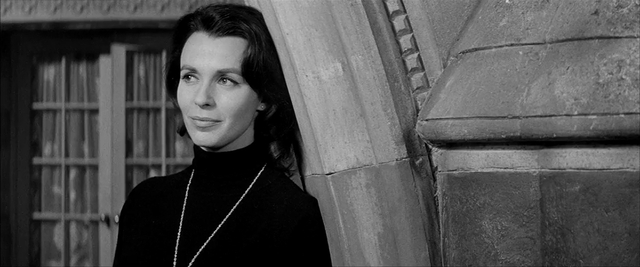
The '60s was a strange time for gay women in cinema, and it's hard to find a consistent stereotype among films as different as The Children's Hour, Walk on the Wild Side, The Fox, Reflections in a Golden Eye, The Group or The Killing of Sister George. Lesbian characters were inevitably titillating elements in a story, but there was no dominant archetype like the predatory older woman or the diesel dyke. Theodora is described by Jackson as very feminine, from a bohemian demimonde, painted in pastel hues. Jackson's story includes a roommate and a heated argument, which Wise thought about filming but decided to exclude:
"Things were said on both sides which only time could eradicate; Theodora had deliberately and heartlessly smashed the lovely little figurine her friend had carved of her, and her friend had cruelly ripped to shreds the volume of Alfred de Musset which had been a birthday present from Theodora, taking particular pains with the page which bore Theodora's loving, teasing inscription."
Given rooms with an adjoining bathroom, Wise and screenwriter Nelson Gidding (who would work with Wise on I Want to Live!, Odds Against Tomorrow, The Andromeda Strain and The Hindenburg) make the women two sides of a triangle that includes Markway when the professor starts taking an obvious interest in Eleanor, which sharpens the dialogue between the trio throughout the film. It's actually hard to decide what's more unsettling – the groans and bangs that issue from the walls of Hill House or the sudden angry explosions in the dialogue between Theo, Eleanor and Markway.
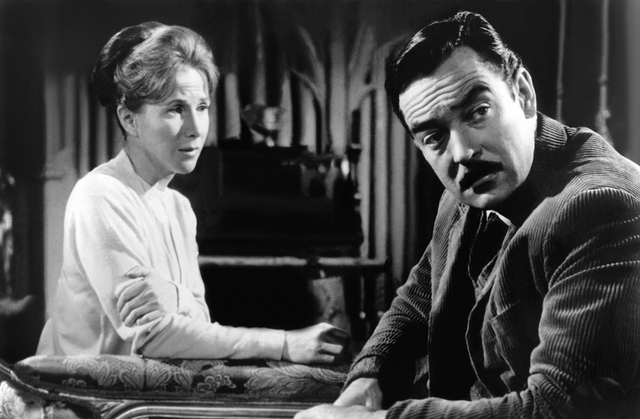
(Richard Johnson is an obscure name today, but he had serious leading man credentials when he made The Haunting and had been, just a few years earlier, director Terence Young's first choice to play Secret Agent 007 in Dr. No. An additional Bond footnote is the brief appearance late in the film of Lois Maxwell, the once and forever Miss Moneypenny, as Markway's brash, skeptical wife.)
The final unwilling, but unbothered, member of Markway's research team is Luke the nephew, who Jackson paints just as sharply as the rest of the quartet. ("Luke Sanderson was a liar. He was also a thief...") She also suggests that the opportunistic young man might be a big of a gigolo:
"...his dishonesty was largely confined to taking petty cash from his aunt's pocketbook and cheating at cards. He was also apt to sell the watches and cigarette cases given him, fondly and with pretty blushes, by his aunt's friends. Some day Luke would inherit Hill House, but he that never thought to find himself living in it."
Tamblyn, who had been one of the Jets in West Side Story, didn't want to make the film, but he was an MGM contract player so the studio forced his hand and he came to consider Luke one of his favorite parts. He certainly has more fun than anyone else in the picture, at least early on, entering the picture mixing martinis and wondering aloud about breaking up the massive sculptures in the gallery for tombstones, selling off the library at 25 cents a book and opening a nightclub in Hill House.
Tamblyn even gets to do a couple of high kicks on the spiral staircase in the library before the stairs start to shudder and sway – just one of the many parts of the house that want to harm its visitors.
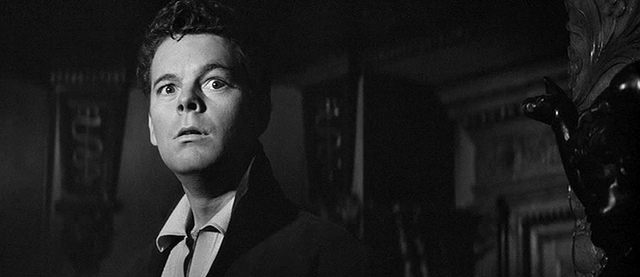
Just how Markway chose his research assistants is vague enough. Theodora is supposed to have some kind of psychic gift whose salient effect is helping her beat Luke in gin rummy, while Eleanor was at the centre of a poltergeist experience as a child, just after the death of her father. But why they're in Hill House is far less important than getting them behind its walls, and the lightning rod of the group is clearly Eleanor, who begins to fall apart the moment she arrives, though she pleads to stay when Markway suggests that she go home.
"Home" is the key to poor Eleanor, who is without one the moment she packs everything she owns in the back of her car, and who makes no secret of her desire to make Hill House her home, no matter how awful it becomes with every nightfall. One of the only three unexplainable events in the whole picture are the words "Help Eleanor Come Home" written in looping chalk letters in a hallway, but no one can dismiss the likelihood that someone in the group – probably Eleanor – was the author.
Less explainable are the bangs, knocks and crashes that besiege first Eleanor, then Eleanor and Theo and finally the whole quartet with each successive night. While the prologue introduced us to Hill House patriarch Hugh Crain and his luckless family, their ghosts never make the scene; it's the house that does the haunting, groaning and beating against its own walls and doors.
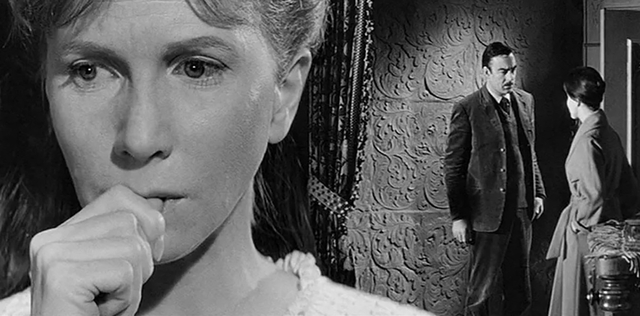
Most of the heavy lifting is actually done by Wise's camera, agile and unsettling as it swoops and pans around shots framed with wide lenses and deep focus, in rooms lit with deep, inky shadows. There is certainly a lot of talking in The Haunting: characters snipe at each other and try to explain themselves all day while they're struck dumb with fear at night.
With so little actually seen, what's heard or – more to the point – imagined makes up the majority of The Haunting's horror. But Wise has to deliver the spooky goods at least once, and he does in a single, economical but powerful scene where an ornate door suddenly starts to bend and heave, like a chest straining to breathe. It's a truly terrifying moment, and it comprises the film's sole special effect in the sense that we understand the term today.
Wise's film is the centerpiece today for the argument – a wholly rear guard one considering what horror has become – that what's not seen in a scary movie is more effective than how much can be shown. It's an argument that gets dismissed by historical context: the limits of special effects technology at the time delineated the very strict line between art and camp. Just watch b-movie kitsch like The House on Haunted Hill (1959) to see what I mean.
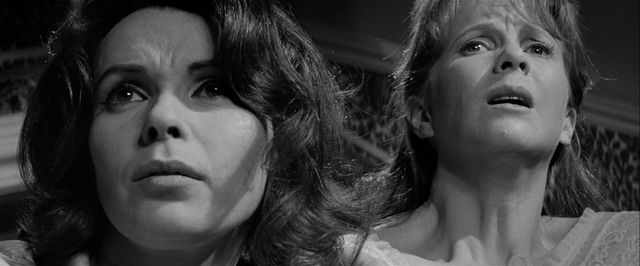
Suggestive, ambiguous horror would find its place in art house pictures by the time Nicholas Roeg made Don't Look Now (1973), and in the meantime horror movie makers pushed the edge of effects technology ever further in pursuit of more explicit scares.
The outer limits of that line was fully on display when Jan de Bont (Twister, Speed 2) did his own adaptation of Jackson's story in 1999 with stars like Catherine Zeta-Jones, Liam Neeson, Lili Taylor and Owen Wilson. De Bont's The Haunting was produced by Dreamworks and began as a collaboration between A-listers Stephen King and Steven Spielberg, and it made the decision to show everything that Wise didn't and Jackson never even imagined, turning Hill House into a lavish but sinister architectural fantasia that comes alive as the professor and his assistants uncover its gruesome secret.
It remains one of the worst-reviewed modern horror films, netting five Golden Raspberry and four Stinkers Bad Movie nominations (winning for Worst Remake).
"Doors turn into giant hands, walls sway, ceilings attack, statuary comes alive and the angry ghost of the house's dead patriarch rages around the mansion like a cyclone" wrote David Ansen in Newsweek. "By the end, the computers have chased all the scares away."
The Haunting of Hill House (2020), the Netflix miniseries adaptation of Jackson's story, released in the middle of successive pandemic lockdowns, took a position somewhere between Wise and de Bont's movies. Turning Jackson's story into a ten-hour series required some serious rewriting, and the cursed Crains were merged with the hapless ghosthunters to tell the story of a family transformed and destroyed by their brief residence in Hill House.
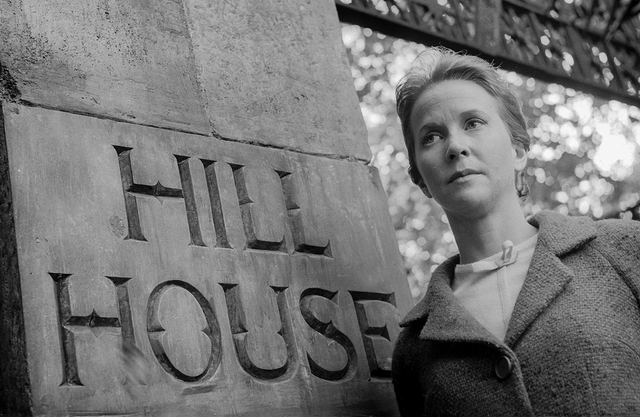
In Wise's movie we experience everything through Eleanor and come to understand her obsession with finding a home, no matter how horrible. The Netflix series, written and directed by horror auteur Mike Flanagan (Oculus, Doctor Sleep, Midnight Mass), updates the story with the much more contemporary obsession with family and childhood being the root and trunk of adult trauma.
For the first few hours Flanagan's version is a tribute to both Jackson's book and Wise's movie, riffing on characters and lines of dialogue, and it manages to be tasteful with its special effects, even if it could have gone far beyond what we saw in the de Bont version two decades earlier. The mood is maintained and the performances are fantastic, even from the children playing the young versions of the Crains.
But the final, emotionally incontinent hour dissolves into mawkishness, as Flanagan strives to achieve the least terrifying outcome in a horror film: closure. Because unlike in life, the most terrifying things in a horror story are the ones we can't do or see or imagine.
Mark Steyn Club members can let Rick know what they think by logging in and sharing in the comments below, as access to the comments section is one of many benefits that comes along with membership in the Mark Steyn Club.


